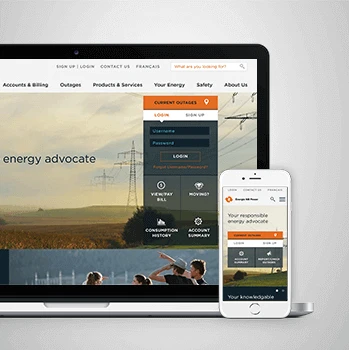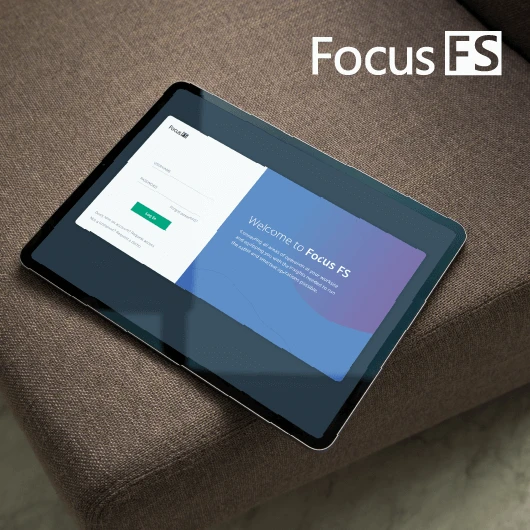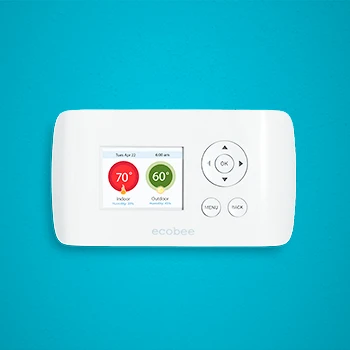How can UX help utilities overcome being taken for granted by customers?
Utilities face the unique challenge that customers only think about you when something goes wrong. Great UX creates positive touchpoints throughout the customer journey - from intuitive bill understanding to proactive energy insights. Our work with NB Power, which became the #1 Canadian utility website, shows how thoughtful design can transform utility relationships from invisible infrastructure to valued partner.
Tip: Focus on creating delightful moments during routine interactions. When paying a bill becomes easy and informative, customers start appreciating your service.
What's your approach to building trust between utilities and skeptical customers?
Trust builds through transparency, consistency, and demonstrated value. We design experiences that clearly show where customer money goes, how utilities invest in infrastructure, and what benefits customers receive. Experience Thinking ensures your brand promise of reliability extends through every digital touchpoint, bill format, and customer communication, creating coherent trust-building experiences.
Tip: Make complex utility operations understandable through clear visualizations and plain language. Transparency about costs and investments builds credibility.
How do you help utilities demonstrate value beyond just keeping the lights on?
Modern utilities offer much more than basic service - energy efficiency programs, renewable options, and smart home integration. We design experiences that surface these values through personalized dashboards, proactive recommendations, and clear benefit communications. Our Ecobee smart thermostat work shows how utilities can become partners in customers' sustainability journeys.
Tip: Create personalized energy insights that show customers how your programs save them money. Concrete examples resonate more than abstract benefits.
What role does UX play in improving utility customer satisfaction scores?
UX directly impacts every satisfaction driver - ease of doing business, problem resolution, and perceived value. We identify friction points across all channels and design solutions that make interactions effortless. By applying Experience Thinking to map brand, content, product, and service touchpoints, we ensure consistent quality that drives satisfaction scores upward.
Tip: Measure satisfaction at multiple journey points, not just after problems. Understanding satisfaction during routine interactions reveals improvement opportunities.
How can utilities use UX to shift from commodity provider to trusted advisor?
The shift requires demonstrating expertise that helps customers make better energy decisions. We design experiences that provide actionable insights, personalized recommendations, and educational content that positions utilities as knowledgeable partners. This transformation touches all four Experience Thinking quadrants - from brand positioning to service delivery.
Tip: Start with high-value advisory services for engaged customers, then expand successful approaches to broader segments.
What's your strategy for humanizing utility brands through digital experiences?
Utilities often feel faceless and bureaucratic. We humanize brands by designing conversational interfaces, showing the people behind the service, and creating empathetic error messages and support experiences. Our approach ensures technical accuracy while maintaining warmth and approachability across all customer touchpoints.
Tip: Include employee stories and local community involvement in your digital experiences. Showing human faces builds emotional connections.
How do you address the challenge of mandatory utility relationships?
When customers can't choose their provider, every interaction matters more. We design experiences acknowledging this unique relationship while demonstrating commitment to customer service. Focus shifts from competitive differentiation to showing responsiveness, fairness, and community investment. Great UX can transform captive customers into genuine advocates.
Tip: Emphasize customer control where possible - payment options, communication preferences, and service choices. Autonomy improves satisfaction even in monopoly contexts.
How do you design for emergency and outage scenarios?
Emergency experiences require exceptional clarity under stress. Our NB Power project specifically addressed users accessing the site during emergencies - designing for quick outage reporting, clear status updates, and mobile optimization for power-out scenarios. We ensure critical information is accessible even on limited bandwidth and provide offline fallbacks where possible.
Tip: Test emergency flows with users under simulated stress conditions. What seems clear in normal circumstances may confuse during actual emergencies.
What's your approach to outage communication and status updates?
Effective outage communication balances transparency with avoiding information overload. We design progressive disclosure systems - showing essential information first (estimated restoration time) with optional deeper details. Real-time maps, personalized notifications, and clear status indicators keep customers informed without overwhelming them during stressful situations.
Tip: Provide restoration time confidence levels, not just estimates. Customers appreciate knowing whether estimates are preliminary or firm.
How do you ensure utility websites work during high-traffic emergencies?
Emergency preparedness requires technical architecture and UX design working together. We design lightweight emergency modes, implement intelligent caching, and create static fallback pages. Content prioritization ensures critical information loads first. Our experience shows that preparing for 100x normal traffic during emergencies is essential for maintaining customer trust.
Tip: Create a separate, ultra-lightweight outage page that can handle massive traffic spikes. Full functionality matters less than basic information availability.
What special considerations exist for vulnerable customer populations during outages?
Vulnerable populations - elderly, medical equipment users, and low-income customers - need special consideration during outages. We design clear priority restoration information, easy medical equipment registration, and accessible communication channels. Multi-language support and alternative format options ensure critical information reaches everyone who needs it.
Tip: Partner with community organizations serving vulnerable populations. They provide insights into specific needs and communication preferences.
How do you design for field service coordination during emergencies?
Field service coordination requires different interfaces optimized for mobile workers, dispatch centers, and customer communication. We design systems that provide real-time crew status, enable efficient routing, and automatically update customer communications. Integration between field operations and customer-facing systems ensures accurate, timely information flow.
Tip: Shadow field crews during actual emergencies to understand their information needs and constraints. Design must work in all weather conditions.
What's your approach to post-outage communication and service recovery?
Post-outage communication offers opportunities to rebuild trust and demonstrate competence. We design follow-up experiences that explain what happened, what's being done to prevent recurrence, and acknowledge customer inconvenience. Thoughtful service recovery can actually strengthen customer relationships when done well.
Tip: Send personalized post-outage communications acknowledging specific customer impacts. Generic messages feel dismissive after major disruptions.
How do you balance automated and human responses during crises?
Crisis response requires thoughtful automation that handles routine queries while escalating complex situations to humans. We design intelligent routing systems, clear escalation paths, and interfaces that help human agents quickly understand customer situations. The goal is efficiency without losing the human touch when customers need it most.
Tip: Always provide a clear path to human assistance during emergencies. Automated systems should acknowledge their limitations in crisis situations.
How do you approach digital transformation for traditional utility companies?
Utility digital transformation requires balancing innovation with reliability. We start by understanding current customer journeys, identifying quick wins, and building toward comprehensive transformation. Our Experience Thinking framework ensures digital initiatives connect across brand, content, product, and service experiences rather than creating isolated digital silos.
Tip: Begin with customer-facing quick wins that demonstrate value, then use success to build momentum for deeper operational transformation.
What's your strategy for mobile-first utility experiences?
Mobile dominates utility interactions - from outage reporting to bill payment. We design mobile-first experiences optimized for common tasks: quick payments, usage checking, and service requests. Our approach considers varying connectivity, device capabilities, and usage contexts. The NB Power project's mobile optimization contributed to its #1 utility website ranking.
Tip: Analyze your current mobile traffic patterns and optimize for the top 5 tasks first. Perfect execution of common tasks beats comprehensive mediocrity.
How do you integrate utility customer portals with smart home ecosystems?
Smart home integration requires understanding both utility operations and consumer IoT expectations. Our Ecobee experience shows how to bridge utility programs with consumer devices. We design APIs, authentication flows, and data sharing permissions that respect privacy while enabling valuable integrations. The goal is seamless experience across utility and third-party platforms.
Tip: Start with popular platforms (Google Home, Alexa) and high-value use cases (demand response, energy monitoring) to maximize adoption.
What's your approach to paperless billing adoption?
Paperless adoption requires making digital bills more valuable than paper. We design interactive bills with usage insights, payment history, and personalized tips that paper can't match. Clear enrollment processes, trustworthy security messaging, and easy access across devices drive adoption. Experience design makes paperless the preferred choice, not just the eco-friendly one.
Tip: Offer exclusive digital features like usage alerts and detailed analytics to incentivize paperless adoption beyond environmental appeals.
How do you handle the complexity of utility rate structures in digital experiences?
Complex rate structures confuse customers and drive support calls. We design clear rate comparisons, interactive calculators, and personalized recommendations that demystify pricing. Visual explanations, scenario modeling, and plain language descriptions help customers understand their options and make informed choices about rate plans.
Tip: Use customers' actual usage data to show concrete savings from different rate options. Abstract explanations rarely drive behavior change.
What role does UX play in smart meter data presentation?
Smart meter data offers unprecedented insights but can overwhelm customers. We design progressive disclosure interfaces that show meaningful patterns first, with optional deeper dives. Comparisons to similar homes, weather normalization, and actionable recommendations transform raw data into valuable insights that drive behavior change.
Tip: Focus on answering customer questions ('Why was my bill high?') rather than just displaying data. Context and interpretation matter more than precision.
How do you approach omnichannel experience design for utilities?
Utility customers expect seamless experiences across web, mobile, call centers, and field services. We design unified experiences where channel transitions feel natural and information flows smoothly. This requires consistent information architecture, shared design systems, and integrated backend systems. True omnichannel goes beyond consistent visuals to consistent service quality.
Tip: Map customer journeys that naturally cross channels and optimize those transitions first. Starting a request online and completing by phone should feel effortless.
How does Experience Thinking apply to smart energy product design?
Experience Thinking transforms energy products from isolated devices to connected experiences. Successful smart energy products deliver on brand promises (efficiency, comfort), present content clearly (energy data, settings), provide excellent product experience (intuitive controls), and integrate into broader service experiences (utility programs, home automation). This holistic view creates products that truly serve user needs.
Tip: Map your product's role across all four Experience Thinking quadrants early. Gaps in any area can undermine market success.
What's your approach to designing IoT energy management systems?
IoT energy systems require balancing sophistication with simplicity. We design experiences that provide powerful capabilities through progressive disclosure - simple for basic users, advanced for enthusiasts. Integration considerations include data privacy, interoperability standards, and fail-safe operations. Our approach ensures products work standalone while offering richer experiences when connected.
Tip: Design for intermittent connectivity from the start. IoT products must maintain core functionality even when cloud services are unavailable.
How do you ensure energy products work for diverse user capabilities?
Energy products serve everyone from tech-savvy early adopters to elderly users seeking simplicity. We design adaptive interfaces that adjust complexity based on user behavior, provide multiple interaction modalities (touch, voice, app), and ensure accessibility standards are exceeded. Our testing includes diverse user groups to validate universal usability.
Tip: Include installer and service technician needs in your design process. Their experience affects customer satisfaction and support costs.
What's unique about designing consumer-facing utility hardware products?
Utility hardware must balance consumer appeal with utility-grade reliability. Our work shows how to maintain brand consistency while meeting utility program requirements. Considerations include extended lifecycles, harsh environmental conditions, and integration with utility backend systems. Design must appeal to consumers while satisfying utility procurement requirements.
Tip: Involve utility program managers early in hardware design. Their requirements often reveal constraints not apparent from consumer research alone.
How do you approach energy visualization and dashboard design?
Effective energy visualization makes invisible consumption visible and actionable. We can design dashboards that highlight patterns, anomalies, and opportunities rather than just displaying data. Color coding, trend analysis, and contextual comparisons help users understand their energy use. Progressive detail levels serve both casual users and energy enthusiasts.
Tip: Test visualizations with actual user data across seasons. Energy patterns vary dramatically, and designs must work for all scenarios.
What's your strategy for demand response program experiences?
Demand response requires balancing utility needs with customer comfort and control. We can design opt-in experiences that clearly communicate program benefits, show real-time status, and provide override options. Trust builds through transparency about when and how programs activate. Our experiences make participation feel collaborative, not controlling.
Tip: Always show customers the value they're providing and receiving from demand response participation. Concrete benefits drive continued engagement.
How do you design for the connected energy home ecosystem?
Connected homes integrate multiple energy devices - thermostats, EV chargers, solar systems, and batteries. We can design experiences that coordinate these systems intelligently while maintaining user control. Unified dashboards, automated optimization, and clear system status create coherent experiences across diverse devices and manufacturers.
Tip: Design open architectures that accommodate future devices. The connected home ecosystem evolves rapidly, and flexibility ensures longevity.
How do you design experiences that actually drive energy conservation?
Conservation requires moving beyond data display to behavior change. We design experiences using behavioral science principles - social comparisons, goal setting, and timely nudges. Gamification elements, achievement systems, and community challenges make conservation engaging. Our approach connects individual actions to meaningful outcomes like environmental impact or community benefits.
Tip: Focus on specific, achievable actions rather than vague conservation appeals. 'Reduce AC use by 2 degrees' beats 'save energy.'
What's your approach to renewable energy program enrollment UX?
Renewable program enrollment often suffers from complexity and unclear benefits. We design clear value propositions, transparent cost comparisons, and simple enrollment flows. Educational content addresses common concerns while interactive calculators show personalized impacts. The experience builds confidence in renewable choices through clarity and transparency.
Tip: Address the top 3 customer concerns upfront - cost, reliability, and complexity. Removing uncertainty increases enrollment rates.
How do you make sustainability data meaningful to average customers?
Sustainability metrics like kWh or carbon tonnes mean little to most people. We translate abstract data into relatable comparisons - 'equivalent to planting 50 trees' or 'like taking 2 cars off the road.' Personal impact tracking, community leaderboards, and achievement milestones make sustainability tangible and motivating.
Tip: Let customers choose which sustainability metrics matter to them - cost savings, environmental impact, or community contribution. Personal relevance drives engagement.
What role does UX play in electric vehicle charging experiences?
EV charging introduces new utility touchpoints requiring seamless experiences. We design interfaces for home charging setup, public charging navigation, and utility program enrollment. Considerations include payment flows, charging scheduling, and grid impact visualization. The goal is making EV charging as simple as traditional fueling while leveraging digital advantages.
Tip: Design for the entire charging journey - finding, initiating, monitoring, and paying. Fragmented experiences frustrate EV adoption.
How do you design for distributed energy resource management?
Distributed resources like solar panels and home batteries require new UX paradigms. We design interfaces that show energy flows, optimize usage automatically, and provide manual control when needed. Complex technical systems become understandable through clear visualization and intelligent defaults. Users feel empowered rather than overwhelmed by their energy independence.
Tip: Provide both simple automatic modes and advanced manual controls. Different users have different comfort levels with energy management complexity.
What's your strategy for community energy program interfaces?
Community energy programs require social features and collective impact visualization. We design experiences that show individual contributions to community goals, facilitate neighbor comparisons, and celebrate collective achievements. Social proof and community pride become powerful motivators for sustained participation in efficiency programs.
Tip: Make community impact visible through public dashboards or displays. Social visibility amplifies program participation and impact.
How do you balance environmental messaging with practical customer benefits?
While environmental benefits matter, practical benefits often drive behavior change. We design experiences that lead with personal value - cost savings, comfort, convenience - while reinforcing environmental impact. This dual messaging reaches both environmentally motivated customers and pragmatic users, maximizing program participation and impact.
Tip: Segment your messaging based on customer motivations. Let users self-select whether they want to focus on savings or sustainability.
How do you reduce call center volume through better digital experiences?
Most utility calls stem from confusion or inability to self-serve online. We identify top call drivers through analysis, then design digital solutions that preemptively address these needs. Clear information architecture, proactive communication, and intuitive self-service tools can reduce call volume while improving customer satisfaction.
Tip: Place 'top 5 call reasons' solutions prominently on your homepage during relevant seasons. Proactive answers prevent reactive calls.
What's your approach to utility customer onboarding experiences?
Moving service requires complex coordination but offers relationship-building opportunities. We design onboarding flows that simplify setup, clearly communicate requirements, and introduce valuable services. Progressive disclosure prevents overwhelming new customers while ensuring nothing important is missed. Great onboarding sets positive relationship tone.
Tip: Send welcome series communications introducing one feature at a time. Overwhelming new customers with everything at once reduces engagement.
How do you design payment experiences that reduce late payments?
Late payments often result from friction, not inability to pay. We design payment experiences with multiple options, clear due date communication, and easy scheduling features. Proactive payment reminders, flexible autopay options, and quick payment methods reduce delinquency. The experience makes on-time payment the easiest option.
Tip: Offer 'pay on your payday' scheduling that aligns with customer cash flow. Fixed monthly dates don't work for everyone.
What's your strategy for high-bill alert and explanation experiences?
Bill shock damages customer trust and drives complaint calls. We design proactive high-bill alerts that explain increases before bills arrive. Interactive bill analysis tools help customers understand usage drivers and find savings opportunities. Clear visualization and plain language explanations reduce confusion and support calls.
Tip: Send mid-cycle alerts when usage tracking significantly higher than normal. Early warnings allow customers to adjust behavior.
How do you handle complex utility program enrollment and management?
Utilities offer numerous programs - budget billing, efficiency rebates, time-of-use rates - that confuse customers. We design program finders that recommend relevant options based on customer profiles. Unified program dashboards show enrollment status, benefits received, and additional opportunities. Simplification drives participation and satisfaction.
Tip: Create a 'program matchmaker' tool that recommends programs based on customer usage patterns and preferences. Personalization increases relevance.
What's your approach to service appointment scheduling and tracking?
Service appointments disrupt customer schedules and require clear communication. We design scheduling systems offering convenient time slots, real-time technician tracking, and proactive updates. Two-way communication channels and arrival notifications reduce customer anxiety. The experience respects customer time while maintaining operational efficiency.
Tip: Offer narrow appointment windows (2 hours or less) with real-time tracking. Customers value time certainty over scheduling flexibility.
How do you design for utility customer preference management?
Customers want control over how utilities communicate with them. We design preference centers that clearly show what communications customers receive and why. Granular controls, channel preferences, and easy updates empower customers. Respecting preferences builds trust and reduces opt-outs from valuable communications.
Tip: Default to customer-friendly preferences and make opting out of marketing separate from operational communications. Maintain trust while enabling engagement.
How do you approach AI integration in utility customer experiences?
AI enhances utility experiences through intelligent energy insights, predictive maintenance alerts, and personalized recommendations. We design AI interfaces that maintain transparency about how recommendations are generated while keeping interactions simple. Our approach ensures AI augments human decision-making rather than replacing it. Trust builds through explainable AI that customers understand and control. Applications include usage prediction, anomaly detection, and customized efficiency recommendations.
Tip: Start AI implementation with internal-facing applications to prove value before customer-facing deployments. This builds organizational confidence and refines approaches.
What's your strategy for blockchain in energy trading platforms?
Blockchain enables peer-to-peer energy trading and renewable energy certificates, but complexity can overwhelm users. We design interfaces that hide technical complexity while maintaining transparency about transactions. Clear visualization of energy flows, simple trading interfaces, and trust indicators make blockchain benefits accessible to average users.
Tip: Focus on user benefits (cost savings, renewable support) rather than blockchain technology. Technology should be invisible unless users want details.
How do you design for predictive maintenance customer communications?
Predictive maintenance can prevent outages but requires careful customer communication. We design notification systems that explain predictions clearly, outline prevention steps, and schedule convenient maintenance. Balancing proactive communication with avoiding unnecessary alarm requires thoughtful message design and timing strategies.
Tip: Frame predictive maintenance as customer benefit, not utility convenience. Show how prevention avoids future disruption.
What role does UX play in virtual power plant interfaces?
Virtual power plants aggregate distributed resources but require customer participation and trust. We design interfaces showing real-time participation status, community impact, and individual benefits. Clear opt-out controls and transparency about when resources are accessed maintain customer comfort with automated systems.
Tip: Gamify virtual power plant participation with community leaderboards and achievement systems. Social dynamics drive sustained engagement.
How do you approach augmented reality for field service applications?
AR enhances field service efficiency and safety through visual work instructions and remote assistance. We design AR interfaces optimized for hands-free operation, clear information hierarchy, and varied lighting conditions. Integration with work order systems and knowledge bases provides technicians with contextual information when needed.
Tip: Test AR interfaces in actual field conditions - rain, bright sun, and cold weather. Laboratory testing misses critical usability issues.
What's your approach to voice interface design for utility services?
Voice interfaces offer hands-free utility interactions but require different design paradigms. We design conversational flows for common tasks like balance inquiries, payment, and outage reporting. Natural language processing handles varied phrasings while clear prompts guide users. Voice becomes another channel in truly omnichannel experiences.
Tip: Design voice interfaces for noisy environments and non-native speakers. Utility customers use voice interfaces in challenging contexts.
How do you ensure emerging technology experiences remain accessible?
New technologies risk excluding vulnerable populations without careful design. We ensure AI, IoT, and other emerging technologies include accessible alternatives, clear fallback options, and support for assistive technologies. Innovation must serve all customers, not just early adopters. Inclusive design principles guide all technology implementations.
Tip: Include accessibility advocates in emerging technology pilots. Their feedback prevents exclusionary designs before widespread deployment.









